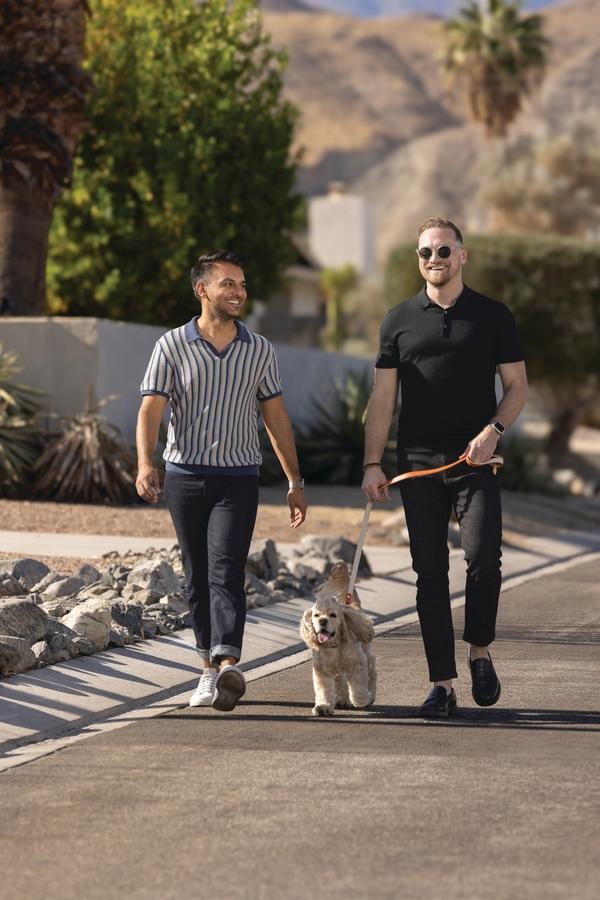



“I literally couldn’t breathe,” says Aulakh, 34.
Growing up, he learned to carry his rescue inhaler everywhere to keep his airways open, but it only provided temporary relief.
Fast forward to 2020, when he and his partner, Jed Haskins, 43, moved from Los Angeles to Palm Springs, where wind-blown pollen exacerbated Aulakh’s asthma. It also worsened Haskins’ allergy symptoms. He woke each day with a stuffy nose.
“I knew I was allergic to some things, but wasn’t sure what to do,” says Haskins.
Both yearned for a dog. Despite Aulakh’s breathing issues, they tried fostering a dog for a traveling friend. When the time came to return the dog, “the house felt empty,” says Haskins.
Aulakh turned to the Eisenhower Allergy and Immunology Clinic for help, where he was surprised when Vincent Devlin, DO, Board Certified in Allergy/Immunology and Pediatrics, began addressing Aulakh’s allergies as a front-line treatment for his asthma.
“It was a total switch in how he looked at the problem compared with all the other doctors I’d seen - a path I’d never taken,” Aulakh says.
Impacting your entire life
“Allergies often play a large role in a patient’s control of their asthma,” says Dr. Devlin. “Allergies affect every part of your life. If they’re bad, you can’t sleep, can’t breathe, can’t do the things you enjoy. Here in our clinic, we’re in the business of making people feel better.”
In the U.S, about 32% of adults and 27% of children younger than age 18 have an allergy, according to the Centers for Disease Control and Prevention’s National Center for Health Statistics. Almost 5 million office visits annually were for asthma.
Common triggers for allergic rhinitis or hay fever include: cats and dogs, dust mites, pollen, molds and - in Coachella Valley’s golf-course country - grass. In addition to airborne allergies, the Clinic treats patients of all ages for animal and food allergies. Symptoms range from mild to severe, and can target the skin, eyes, nose, throat and stomach. A specialized drug allergy program assesses possible reactions to medications, clearing them for use when appropriate.

The Clinic also treats immune deficiency disorders, such as common variable immunodeficiency, which causes low levels of proteins in the body that fight infections. Treatment involves replacement antibodies from a healthy donor.
Aulakh and Haskins signed on for the Clinic’s “desensitization” program. It gradually exposes the immune system to small amounts of allergens to which they are sensitive, causing the body to become less reactive over time.
Aulakh says his allergy tests showed he was, “pretty much allergic to everything.”
Haskins’s allergies were more specific, focused on weeds, olive trees and horses.
“We give a patient a tiny, tiny dose, like a 10,000th of what may be a typical exposure,” says Dr. Majid. “Over time we increase that until reaching the effective therapeutic level.”
The standard protocol is one allergy shot per week for 29 weeks. Then, patients receive a monthly maintenance dose for three to five years.
“Most people are symptom-free at that point and able to discontinue the shots,” says Dr. Devlin. “We think the benefit is lifelong.”
The Clinic is the only practice in the region offering accelerated allergy shots, allowing a patient to reach the goal dose more quickly.
There are two accelerated options for immunotherapy buildup. The first option, cluster: three rounds of shots per visit over four visits generally spaced a week apart. Nine additional visits (typically weekly, or if tolerated, more often) continue to build toward the goal dose. Aulakh and Haskins opted for the fastest delivery, or rush immunotherapy, receiving seven rounds of shots in a single day, followed by the nine additional visits.

Within six months, Aulakh no longer reached for his inhaler before a workout, hike or run. He could now do those things without wheezing or shortness of breath.
“For me, the process has been totally life changing,” he says.
For Haskins, the difference was negligible at first. Dr. Devlin revamped the medication formula and Haskins restarted the program.
“Within a few weeks, I felt exponentially better,” he says. The stuffy nose was disappearing.
Haskins and Aulakh have achieved another major goal - welcoming their own dog into their lives. Cooper, an adorable 3-year-old cocker spaniel, rules the roost. The family routinely travels together. Each night, at home or on the road, Cooper commands prime bed position. Everyone breathes deeply.
To learn more about the Eisenhower Allergy and Immunology Clinic visit EisenhowerHealth.org/AllergyRelief